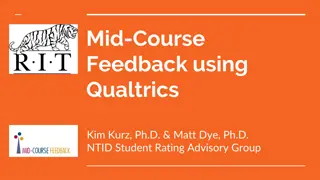Enhancing Assessment and Feedback in Online Teaching
Explore the importance of clear course grading policies, frequent assessments, and student self-assessment in online teaching. Learn about Classroom Assessment Techniques (CATs), their benefits, and strategies to assess instruction effectively. Discover the role of CATs in promoting a student-centered learning environment and addressing underutilization challenges.
Download Presentation

Please find below an Image/Link to download the presentation.
The content on the website is provided AS IS for your information and personal use only. It may not be sold, licensed, or shared on other websites without obtaining consent from the author.If you encounter any issues during the download, it is possible that the publisher has removed the file from their server.
You are allowed to download the files provided on this website for personal or commercial use, subject to the condition that they are used lawfully. All files are the property of their respective owners.
The content on the website is provided AS IS for your information and personal use only. It may not be sold, licensed, or shared on other websites without obtaining consent from the author.
E N D
Presentation Transcript
Session 7: Assessment and Feedback Heather Rippetoe Center for Innovation in Teaching and Learning
Assessment and Feedback 6. 6. 44. Assessment and Feedback Assessment and Feedback Course grading policies, including consequences of late submissions, are clearly stated in the course information area or syllabus. Course includes frequent and appropriate methods to assess learners mastery of content. Criteria for the assessment of a graded assignment are clearly articulated (rubrics, exemplary work). Learners have opportunities to review their performance and assess their own learning throughout the course (pre-tests, automated self-tests, reflective assignments, etc.). Learners are informed when a timed response is required. Proper lead time is provided to ensure there is an opportunity to prepare an accommodation. Learners have easy access to a well-designed and up-to-date gradebook. Learners have multiple opportunities to provide descriptive feedback on course design, course content, course experience, and ease of online technology. 45. 46. 47. 48. 49. 50.
Session 7 Agenda Classroom Assessment Techniques (CATs) CATs for instruction How CATs benefit students Digitizing CATs
What are CATs? Who are the CATs gurus? What do CATs assess?
Who are the CATs gurus? Angelo & Cross (1993). Classroom Assessment Techniques: A Handbook for College Teachers, 2nd Edition.
What do CATS assess? Course-related knowledge and skills Learner attitudes, values, and self-awareness Learner reactions to teachers and teaching Learner reactions to instruction Learner reactions to class activities, assignments, and materials
What's the CATs cycle? Kruiper et al, 2022
Interesting notes ... CATs help move from a teaching-centered to a student-centered classroom (Cross & Palese, 2015; Hanson & Florestano, 2020). CATs are often underutilized (Hanson & Florestano, 2020, p. 49).
CATs for instruction Why assess instruction? Which CATs assess instruction?
Why assess instruction? Increase faculty feedback literacy (Carless, 2022) Inform course curriculum design (p. 54) - go ahead and work them in to your course schedule. Know when and which ones you will use throughout the semester. Encourage effective teaching and reflection (p. 54) -- CATs remind instructors that teaching is an ongoing process of inquiry, experimentation, and reflection. Improve classroom environment Carless, 2022; Hanson & Florestano, 2020
Which CATs assess instruction? Learner reactions to instruction Learner reactions to class activities, assignments, and materials o Critical incident questionnaire (Brookfield) o RSQC2 o Group work evaluations o Reading rating sheets o Assignment assessments o Exam evaluations Learner reactions to teachers and teaching Teacher-designed feedback forms (Angelo & Cross, 1993). See Forms A & B (Vanderbilt) for an example. The SGID
How CATs benefit students Why is it important to share results with students? What does assessing instruction model for students?
ENCOURAGES STUDENT-CENTERED DESIGN (ANGELO & CROSS, 1993; HANSON & FLORESTANO, 2020) What does assessing instruction model for students? PROVIDES JUST-IN-TIME INFORMATION FOR ADAPTATION (MARX, 2019) DEMONSTRATES/MODELS INFORMATION GATHERING AS PROFESSIONAL DEVELOPMENT AND OPPORTUNITY IMPROVEMENT (ANGELO & CROSS, 1993, MARX, 2019) MODELS PROCESS (HANSON & FLORESTANO, 2020)
Digitizing CATs How can we use iLearn for CATs? How can we use Qualtrix for CATs?
References Angelo, T.A. & Cross, K. P. (1993). Classroom Assessment Techniques: A Handbook for College Teachers. 2nd Ed. Jossey-Bass. Critical Incident Questionnaire Stephen D. Brookfield (stephenbrookfield.com) Brookfield, S. D. (n.d). Critical Incident Questionnaire. Critical Incident Questionnaire Stephen D. Brookfield (stephenbrookfield.com) Carless, D. (2022). Feedback Literacy for Academics. Feedback Literacy for Academics - Social Contexts and Policies of Education (SCAPE) (hku.hk) Cross, T. & Palese, K. (2015). Increasing learning: Classroom assessment techniques in the online classroom. American Journal of Distance Education (29)2, 98-108, https://doi.org/10.1080/08923647.2015.1023594 Kruiper, S. M., Leenknecht, M. J., & Slof, B. (2022). Using scaffolding strategies to improve formative assessment practice in higher education. Assessment & Evaluation in Higher Education (47)3. 458-476. https://doi.org/10.1080/02602938.2021.1927981 Marx, R. (2019). Soliciting and utilizing mid-semester feedback. Vanderbilt University Center for Teaching. https://cft.vanderbilt.edu/guides-sub-pages/student-feedback/























